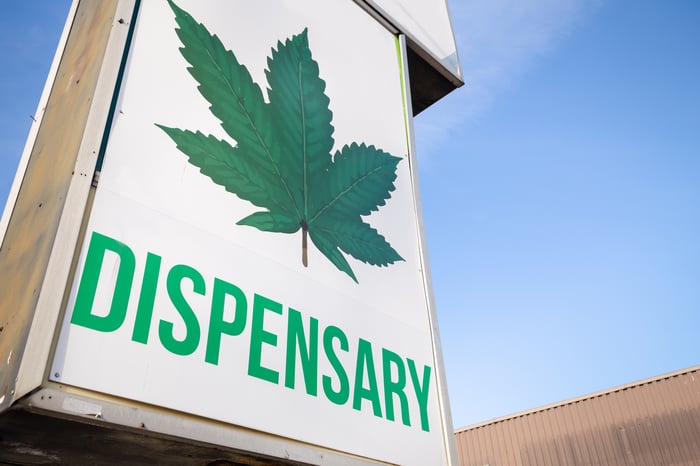For years, marijuana stocks were virtually unstoppable. The prospect of $50 billion or more in annual worldwide sales by 2030 sent North American cannabis stock valuations into the stratosphere. But over the past 13 months, most pot stocks have seen their valuations retrace anywhere from 50% to 95%. It's been ugly, with a capital "U."
But more specifically, Canada has been an absolute train wreck. Our northerly neighbor was widely expected to pave a path forward for other countries to follow. Instead, its pot industry has struggled since day 1. Initially pegged as a $5 billion (per year) industry, Canada might be on track for $1 billion in total sales in 2020.

Image source: Getty Images.
Perhaps the one bright spot for Canada was the expected launch of derivatives (e.g., edibles, vapes, infused beverages, topicals, and concentrates). Initially expected to happen in October, regulatory agency Health Canada pushed back the official rollout of "Cannabis 2.0" by two months.
What made the launch of derivatives so exciting is that these alternative consumption products offer much higher margins than traditional dried cannabis flower. With less chance for oversupply and commoditization, Cannabis 2.0 was expected to be a pathway to profitability for pot stocks.
Additionally, Cannabis 2.0 products tend to speak to a younger generation of users, and will therefore bring a more diverse group of clients into dispensaries. Since favorability toward legalization is highest among younger adults, they're a logical target for these high-margin products.
Unfortunately, the initial launch of these alternative consumption options is liable to disappoint for a variety of reasons. With Statistics Canada reporting a nearly 3% sequential month slide in legal cannabis sales in February 2020, it's time to point the finger of blame at these five factors for holding back Cannabis 2.0.

Image source: Getty Images.
1. Ontario's inadequate retail footprint
Perhaps the biggest issue for the Canadian pot industry is the persistent licensing issues plaguing Ontario, the country's largest province by population. Despite 38% of Canada's residents living in Ontario, only a little over four dozen dispensaries were open, as of March 2020. By comparison, this is a province that could comfortably house 1,000 retail locations.
Provincial regulators initially assigned retail licenses based on a lottery system. However, this system only led to 24 stores being open by Oct. 17, 2019, the one-year anniversary of recreational sales commencing. On Dec. 31, 2019, Ontario shelved its lottery system in favor of more traditional application vetting process. This sounded like a great plan -- then the coronavirus disease 2019 (COVID-19) hit and ground the review process to a halt.
It was anticipated that around 250 dispensaries would be open by the end of 2020. That's no longer a guarantee as a result of COVID-19. And without an adequate legal retail network, it's difficult for licensed producers to get high-margin product in front of customers.

Image source: Getty Images.
2. The coronavirus has halted in-store purchases
Another problem stemming from the spread of the coronavirus is that it's closed dispensaries to in-store traffic. While most retail locations are still open in the capacity that they can provide curbside pickup or delivery, no customers are allowed inside dispensaries to browse the cases. In my view, this is liable to reduce the average ticket price per customer since fewer discretionary purchases are being made, and because it's much tougher for dispensaries to introduce their customers to newly launched derivatives.
It's possible we could see a run on derivatives once pot shops fully reopen, but for now COVID-19 is likely hampering, not helping, derivative sales.

Image source: Getty Images.
3. Alberta, Quebec, and Newfoundland & Labrador ban vapes
Don't forget that, in addition to the coronavirus pandemic, the North American marijuana industry is still reeling from the vape-related health scare that emerged in the U.S. last spring and summer. Although most of the vape-related lung illnesses were tied to black-market products containing vitamin E acetate, some of the samples tested found this potential lung irritant in legal-channel vape products.
With vape pen safety a clear concern, we witnessed Alberta ban vape sales between mid-December and mid-February, while Quebec and Newfoundland & Labrador have vaping products bans still in effect today. These laws are certainly subject to change, just as Alberta altered its policy after a two-month ban, but they're directly reducing the sales potential of what was expected to be the top-selling derivative product (i.e. vapes) in the meantime.
These bans are especially hurtful to Cronos Group (CRON -1.70%), which landed an equity investment from tobacco giant Altria Group in March 2019. Cronos Group is expecting to leverage its partnership into a successful launch of vape products in Canada, but is finding that Canada's largest provinces are either a mess on the supply front or closed for business when it comes to vapes. In short, expect Cronos Group to continue to disappoint in the sales column.

Image source: Getty Images.
4. Balance sheet constraints
Some part of the blame for a weak Cannabis 2.0 launch likely lies with licensed producers whose balance sheets are an absolute mess.
At this time last year, pot stocks appeared to have plenty of capital/or and relatively easy access to financing. That's not the case anymore, with practically every grower in Canada halting construction on remaining projects or idling assets to conserve capital. In other words, the full-bore production that Wall Street and pot stock investors were counting on last year simply isn't going to come to fruition.
For example, HEXO (HEXO) was expected to focus heavily on derivative production and yield 150,000 kilos of equivalent output each year, at its peak. Instead, HEXO has laid off 200 workers, completely shuttered its Niagara facility that was acquired via the Newstrike Brands acquisition, and has been forced to sell its common stock on a number of occasions in recent months to raise capital. HEXO is also being sued by extraction-service provider MediPharm Labs over an alleged payment it did not make. With HEXO also taking a writedown on a portion of its inventory, it's evident that it, and a number of its peers, are in no shape to go full-bore on a derivatives launch.
5. The weather
Finally, go ahead and blame Mother Nature for an expected weak launch of derivatives. In Toronto, Canada's most-populated city, the average daily high between December and March usually ranges from 30F to 40F, with the city averaging almost four feet of snow per year. Consumers are less willing to go out when it's cold, wet, or snowing outside, making it likely that we see some initial weakness in Cannabis 2.0 sales as a result of the timing of when these products were launched.





